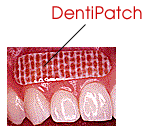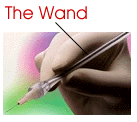Perhaps one of the most dreaded instruments of all time is the dental drill. Just the sound of a dental drill is likely to make one shudder. Now a new technology called air abrasion may one day eliminated drills forever.
Air abrasion works on teeth much like a sand blaster works on a building. Tiny particles of aluminum oxide are blasted in a stream of water to remove the decayed debris and ruined enamel of cavities. This system is nearly painless and eliminates the need for needle numbing shots. The air abrasion sytem is more precise than conventional drills allowing the dentist to save healthy enamel that surrounds the cavity.
No More Needles
The thought of being stuck inside our mouth with a needle is discomforting. For centuries the needle has been the primary way for dentists to inject lidocaine and other anesthetics necessary for dental procedures. A new device called the DentiPatch may change this.
 The DentiPatch, a band-aid looking device, is applied by the dentist to the gums. Here lidocaine diffuses out of the patch and is delivered into the gum tissue. The DentiPatch can be used for most routine dental procedures. In cases where, delivery of anesthesia by a needle is neccessary, the DentiPatch can first be applied to prevent the pain of the subsequent needle injection.
The DentiPatch, a band-aid looking device, is applied by the dentist to the gums. Here lidocaine diffuses out of the patch and is delivered into the gum tissue. The DentiPatch can be used for most routine dental procedures. In cases where, delivery of anesthesia by a needle is neccessary, the DentiPatch can first be applied to prevent the pain of the subsequent needle injection.
A new needle anesthesia delivery system may also end painful dental visits. The pain patients experience from needle injections is caused not by the the needle itself but by the rate at which the anesthesia is injected into the gums.
 The slower and more steady the dentist is when he or she injects the anesthesia the less painful the injection. Most dentists, however, can not inject the anesthesia slowly enough or at a steady enough rate to totally eliminate pain.
The slower and more steady the dentist is when he or she injects the anesthesia the less painful the injection. Most dentists, however, can not inject the anesthesia slowly enough or at a steady enough rate to totally eliminate pain.
That is where the Magic Wand comes into play. This new device contains a microprocessor which monitors and controls the rate at which anesthesia enters the gum tissue making the injection virtually pain free. Most patients simply feel pressure rather than pain when the Magic Wand is used.
 A new device may one day eliminate the need for anesthesia altogether. Electrical nerve stimulation works by stimulating the mouth with a small amount of electricity. The precise mechanism by which electrical anesthesia works is actually unknown. Some theorize that it may temporarily affect the pain nerves of the mouth so that they can no longer send pain impulses or that the stimulation may cause the release of the body' own pain killers.
A new device may one day eliminate the need for anesthesia altogether. Electrical nerve stimulation works by stimulating the mouth with a small amount of electricity. The precise mechanism by which electrical anesthesia works is actually unknown. Some theorize that it may temporarily affect the pain nerves of the mouth so that they can no longer send pain impulses or that the stimulation may cause the release of the body' own pain killers.
With new technologies the pain and discomfort associated with dental visits may become a thing of the past. Now millions of people who fear going to the dentist may have a new reason to smile.
Related Links
Dentists Say They Really Can Work Pain-Free
A general article on pain-free dentistry which appeared in the USA Today Health Section
Pain-less Dentistry
Health article on air abrasion
Dental Phobia Treatment Center
Conquer your fear of the dentist
Medical Breakthroughs - The Magic Wand
Information on the Magic Wand
The DentiPatch (Lidocaine Transoral Delivery System)
DentiPatch website
Cedata Dental International, Inc.
Information about the Cedata Corporation's electric anesthesia device